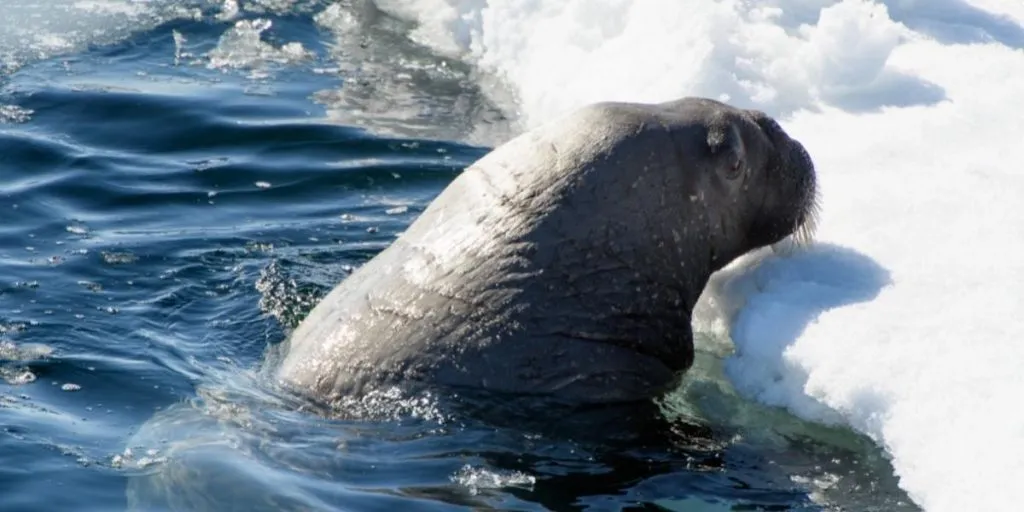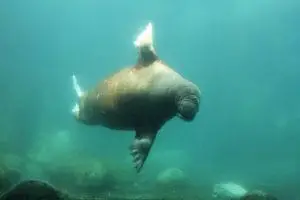Walruses are iconic marine mammals that are easily recognized because of their long and thick tusks. These can look quite intimidating. However, you may be surprised to hear that walrus use their tusks for various purposes, and it is not to kill things. So, why do walruses have tusks?
Walrus tusks are elongated upper canine teeth. Their tusks are important to their survival in the Arctic as they are used to pull their bodies out of the water, to make breathing holes in the ice, and during conflict. They do not use their tusks to kill prey. Both male and female walruses have tusks, although they vary in shape and size.
Keep reading to find out more about the characteristics of walrus tusks, their usages, and why humans hunted walruses for them. Alternatively, check out our top facts about walruses to learn more about these unique animals.
- Why Do Walruses Have Tusks?
- How Much Does a Walrus Tusk Weigh?
- How Big Does a Walrus Tusk get?
- Do Baby Walrus Have Tusks
- What Are Walrus Tusks Made Of?
- Do All Walruses Have Tusks?
- Do Walrus Tusks Grow Back?
- Can You Buy or Sell Walrus Tusks? [US, UK, Australia, and More]
- A Brief History of the Walrus Ivory Trade
- Do Walrus Have Teeth?
- Related Questions
Why Do Walruses Have Tusks?
Walrus tusks are very important for their survival in the Arctic regions1 (source: WWF). One of the main uses of the tusks is to help them ‘haul out’. This is where the walrus uses its tusks to pull its body out of the water and onto sea ice or landmass2 (source: National Geographic).
Another use of their tusks is to keep breathing holes open in the ice – this allows them to breathe in between dives. They also use their tusks during the conflict which is why walruses are considered to be dangerous. This conflict can include defending its territory or protecting itself against predators or other walruses.
Female walruses have been observed to use their tusks to defend their calves3 (source: WWF). Walruses do not use their teeth to kill their prey, nor either dig or rake the sediment4 (source: F.H. Fay, North American Fauna, Vol. 74, No. 74, pp. 1–279, 1982).

How Much Does a Walrus Tusk Weigh?
A singular adult male walrus tusk can weigh up to 4 kilograms. This is slightly heavier than a singular adult female walrus tusk5 (source: R.A. Kastelein, Encyclopedia of Marine Mammals (2nd ed), pp.1212-1217, 2009).
How Big Does a Walrus Tusk get?
Walrus tusks grow throughout their lifespan. Walrus tusks can reach lengths of more than 90 centimeters (35.4 inches)6 (source: National Geographic).
It is normal for male walruses to have bigger tusks than females. An adult female walrus tusk can grow up to 80 centimeters (31.4 inches). This is an example of sexual dimorphism. This is seen particularly in Pacific walruses, where adult males have longer, heavier, and larger tusks than adult females7 (source: F.H. Fay, North American Fauna, Vol. 74, No. 74, pp. 1–279, 1982).
Some research into the length of adult walrus is limited because tusks can appear shorter due to abrasion over time.
Do Baby Walrus Have Tusks
No, walruses are not born with tusks. It takes some time for the upper canines to grow into elongated tusks. This usually happens after the calf’s first summer or fall8 (source: R.W. Boessenecker, “A new Early Pliocene record of the toothless walrus Valenictus (Carnivora, Odobenidae) from the Purisima Formation of Northern California.”, 2017). The tusks are covered in an enamel coating which can appear yellow. This enamel coating is worn away as the walrus matures9 (source: Wikipedia).
What Are Walrus Tusks Made Of?
Walrus tusks are mostly made of dentin. Dentin is a calcareous material that makes the tusks very hard. The inside of a tusk is made of crystalline which is secondary dentin. This composition makes it similar to ivory but is different enough to allow researchers to tell the difference between walrus tusks and elephant tusks10 (source: CAMEO).
Do All Walruses Have Tusks?
Yes, both living subspecies of walruses have tusks. Also, both male and female walruses have tusks11 (source: National Geographic). Walrus grow their tusks (canine teeth) continuously throughout their life.
Sometimes some walruses appear to have lost a tusk. An example of why a walrus may lose its tusk is if the tooth grows too big for its tooth caps12 (source: F.H. Fay, North American Fauna, Vol. 74, No. 74, pp. 1–279, 1982). Recently, researchers have found fossils that infer an extinct species of walrus which did not have teeth13 (source: R.W. Boessenecker, “A new Early Pliocene record of the toothless walrus Valenictus (Carnivora, Odobenidae) from the Purisima Formation of Northern California.”, 2017).
Do Walrus Tusks Grow Back?
Walrus tusks are continually growing, and they do grow back. This is particularly important when a tusk grows too big for its tooth cap and falls out14 (source: F.H. Fay, North American Fauna, Vol. 74, No. 74, pp. 1–279, 1982). This may also be beneficial because sometimes a tusk is damaged during conflict or gets worn down whilst foraging.
Walruses can live to over 40 years old in the wild so their tusks can sometimes grow too big and fall out naturally15 (source: Point Defiance Zoo and Aquarium).
Can You Buy or Sell Walrus Tusks? [US, UK, Australia, and More]
The purchase and sale of walrus tusks is a grey area of the ivory trade. In some places, you can, and in some places, you cannot. This varies internationally and even domestically. It can depend on the purpose of the item and its artistic value16 (source: U.S. Department of the Interior, Indian Arts and Crafts Board, in collaboration with Alaska State Council on the Arts, 2017).
- United States: It is generally legal to buy and sell walrus tusks in the United States, although certain prerequisites have to be met. Furthermore, you can legally purchase walrus tusks that have been processed into artwork produced by Alaskan natives. Alaskan natives can sell directly to non-Alaskan natives. Once sold, it is legal for the walrus ivory to be sold again17 (source: U.S. Department of the Interior, Indian Arts and Crafts Board, in collaboration with Alaska State Council on the Arts, 2017).
You can also buy Pacific walrus ivory which was possessed before the Marine Mammal Protection Act of 1972. However, there are some exceptions such as in New Jersey, there is a state law to prevent ivory products from being traded. Also, these cannot be exported out of the US or imported into the US.
- United Kingdom: Recently the UK has proposed to add further regulations to the trade of walrus ivory. You can now only trade ivory in the UK for a limited number of reasons including musical instruments, selling to museums, or items of outstandingly high artistic, cultural or historical value. Although, it is still legal to own walrus ivory for personal use18 (source: UK Government).
- Australia: Walrus ivory can be sold legally in Australia if the seller can prove it was antique and not “new” ivory, though there is some grey area in the legislation as the main focus is put on the trade of elephant ivory and rhino horns19 (source: Parliament of Australia).
- Other Countries: Canada, Russia, and Greenland do allow for the trade of walrus tusks. In Norway, you cannot legally sell walrus tusks domestically, if it was killed locally after 195220 (source: Smithsonian Magazine).
A Brief History of the Walrus Ivory Trade
The trade of walrus ivory particularly began in the tenth century21 (source: CAMEO). This industry increased during the early medieval period. This is because there was less supply of elephant ivory22 (source: Wikipedia). The walrus tusks were preferred over elephant tusks by some Arabic and Chinese traders due to being harder, whiter, and easy to polish23 (source: B. Laufer, Arabic and Chinese Trade in Walrus and Narwhal Ivory, 1913).
The Inuit communities continue to hunt walruses for subsistence today and have done so for the previous 5,000 years24 (source: DEFRA, UK Government, 2019).
Since prehistoric times, these people have engraved folk art into them. This popularised the trade of walrus tusks. This was particularly popular in Russian communities and even led to dedicated schools which taught the carving25 (source: Wikipedia). This coincided with the manufacture of art objects and the trade of such in medieval Europe.
Interestingly, it was the hunt for walrus ivory that led to the initial exploration and settlement of Greenland. It was likely the decline in the walrus population, facilitated by the hunt, led to the colony being abandoned.
The walrus ivory trade continues to some extent to this day26 (source: U.S. Department of the Interior, Indian Arts and Crafts Board, in collaboration with Alaska State Council on the Arts, 2017). Walrus ivory is also used in the UK to repair older musical instruments. Islamic cultures utilized walrus ivory to form knife handles and sword hilts between the 19th and 19th centuries27 (source: DEFRA, UK Government, 2019).
Do Walrus Have Teeth?
Yes, walruses do have teeth. Walrus teeth are made out of dentin – a hard calcareous material.
The tusks of a walrus are teeth; these are their upper maxillary canines. Their canines are their largest and most deeply rooted teeth. Walrus’ upper canines are called tusks because of their large size. Walruses also have other teeth such as premolars, molars, and incisors28 (source: F.H. Fay, North American Fauna, Vol. 74, No. 74, pp. 1–279, 1982). Before adulthood, the incisor and molar teeth can be reabsorbed29 (source: F.H. Fay, North American Fauna, Vol. 74, No. 74, pp. 1–279, 1982).
Although walrus teeth were once thought to not show any evidence of cavities, recent research states that abrasion of the teeth is common30 (source: E. Guarde, et al, Journal of Experimental Marine Biology and Ecology, Vol. 500, pp.89-99, 2018). Walrus teeth are around 5 centimeters on average, with a rounded yet irregular shape31 (source: B. Laufer, Arabic and Chinese Trade in Walrus and Narwhal Ivory, 1913).
Related Questions
Is It Illegal to Own a Walrus Tusk?
No, it is not illegal to own a walrus tusk in any country. See earlier section for more on this.
Are Walrus Hunted for Reasons Other Than for Their Tusks?
Yes, walruses are not only hunted for their tusks. Sometimes walruses are hunted for food, clothing, their hide and other body parts (skulls, teeth, or bones), and for cultural traditions32 (source: U.S. Department of the Interior, Indian Arts and Crafts Board, in collaboration with Alaska State Council on the Arts, 2017).
Why Do Walruses Have Whiskers?
Walruses appear to have whiskers because of their bristles connected to their snout, called vibrissae33 (source: R.A. Kastelein, Encyclopedia of Marine Mammals (2nd ed), pp.1212-1217, 2009). These are sensory organs connected to muscle and nerves34 (source: Wikipedia). The vibrissae which are placed around the side of the snout (their ‘whiskers’) are longer than the vibrissae in the center. Walruses use their whiskers to detect objects, and vibrations within the water column35 (sources: R.A. Kastelein and M.A. Van Gaalen, Aquatic Mammals, Vol. 14, No. 3, pp.123-133, 1988 and R.A. Kastelein and M.A. Van Gaalen, Aquatic Mammals, Vol. 16, No. 2, pp.78-87, 1990). Therefore, walrus whiskers are important in their foraging activity.
Find out more in our full article about walrus whiskers.
Why Do Walruses Have Mustaches?
Walruses also have vibrissae on the top of their upper lip. These bristles are usually shorter than the whiskers36 (sources: R.A. Kastelein and M.A. Van Gaalen, Aquatic Mammals, Vol. 14, No. 3, pp.123-133, 1988). The walruses use their mustache to distinguish the object’s size, shape, and texture – whereas their whiskers identify the object37 (source: R.A. Kastelein and M.A. Van Gaalen, Aquatic Mammals, Vol. 16, No. 2, pp.78-87, 1990).
Find out more in our full article about why walruses have mustaches.


![You are currently viewing Why Do Walruses Have Tusks? [Everything You Need To Know]](https://polarguidebook.com/wp-content/uploads/2022/06/Why-do-walruses-have-tusks.jpg)
![Read more about the article 16 Tusk-Worthy Facts about Walruses [#7 Will Shock You]](https://polarguidebook.com/wp-content/uploads/2022/09/Walrus-300x200.jpg)

![Read more about the article Where Do Walruses Live? [With Map]](https://polarguidebook.com/wp-content/uploads/2022/06/Where-do-walrus-live-300x150.jpg)